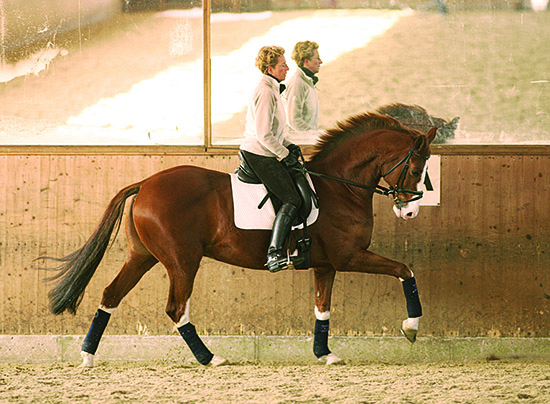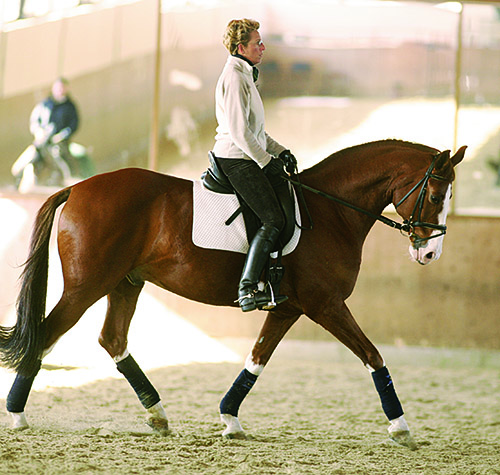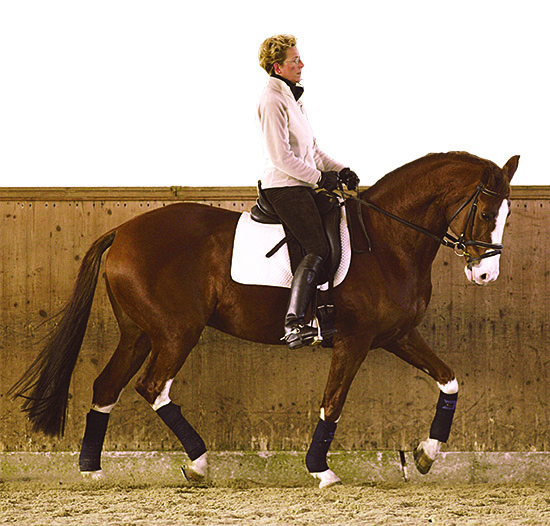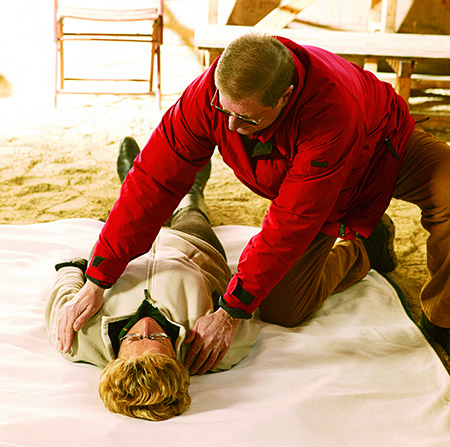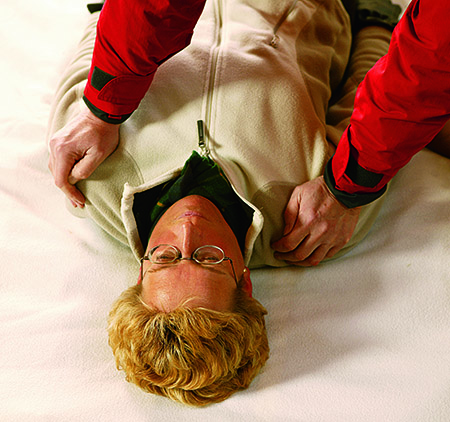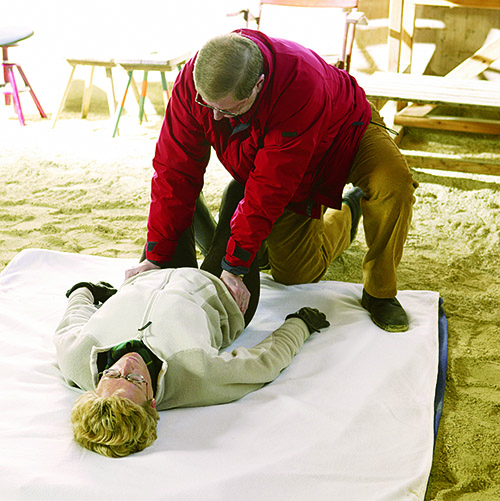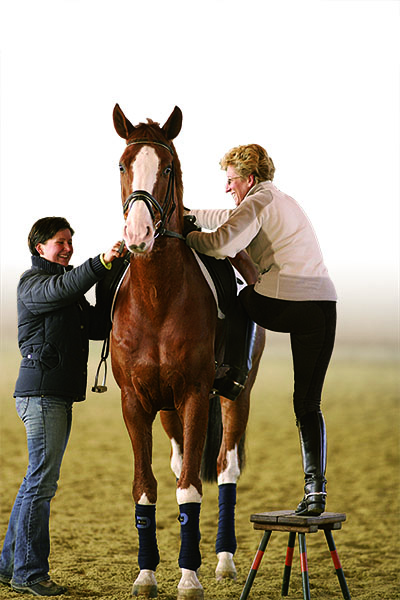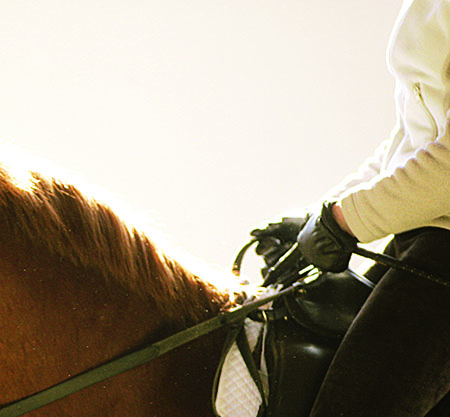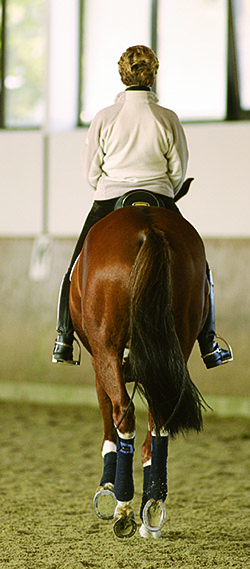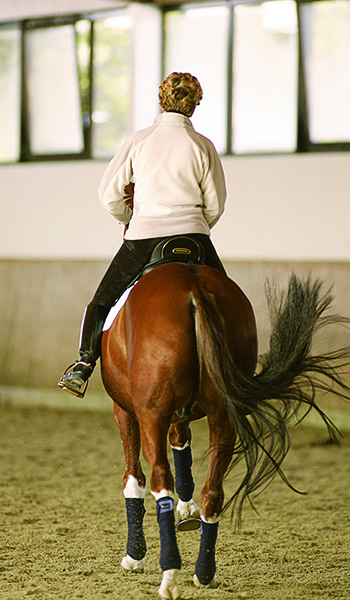Heike Kemmer is a regular in the famous German Dressage Team – and she has worked hard for it. In addition to working on her riding in general, Heike Kemmer has worked on her seat and the effects of her aids with the sports expert Eckhart Meyners for the last year – leading to amazing results. Kerstin Nieman from the German equestrian magazine ST.GEORG was allowed to witness one of these training sessions at Heike Kemmer’s home. Photos by Jacques Toffi
Working on the details: In the picture above Heike still slightly leans forward. In the picture at the top, which was taken after a few exercises, you can see that the centre of gravity of both, horse and rider, has moved further backwards.
At the beginning of the warm-up Heike’s upper body is tilted forward to ‘make herself appear lighter’. A little later it is clearly evident: The elevation of the horse and rider happens nearly simultaneously.
The meticulous work on seat and aids results in a perfect elevation of the horse and rider.
Something is different today in the indoor arena of the training yard “Amselhof” in the village of Walle in Lower Saxony. On the left of the short side of the dressage arena there is a small wooden raised platform, strange utensils which actually belong in a gymnasium lie on the floor. A few mats and rugs lie in the carefully raked sand and small mounting blocks are distributed here and there. In the middle stands a very unsteady looking three-legged chair, which looks as though it could tip over at any minute.
Today Heike Kemmer and two other riders working for her, Mayke Liebregts and Maresa Cordugas, have organised something special for their three horses – and for themselves: Today Dave Dunley, Albano and Graf Luckner are not under the scrutiny of a riding instructor, but of an expert on ‘the Principles of Movement’. His lesson seems rather different from that what one generally expects of a riding lesson…
Indeed, this expert cannot ride. Nevertheless, he is well-known in the equestrian scene. Eckhart Meyners, lecturer at the university of Lüneburg, has spent about 30 years researching – in simple terms– how the movements of rider and horse can be best aligned in order to improve the rider’s awareness and sensitivity for the horse’s movement; his studies are largely in aid of the well-being of the four-legged friend, which is not only substantially more comfortable under a supple rider but also ‘can be moved’ to achieve higher levels of performance.
Get on the floor!
In the first quarter of an hour everything looks like it usually does during any day of the year: Heike Kemmer sits on the 11-year-old Hanoverian Dave Dunley, walks him, starts to trot and in a textbook-manner she first rides big circles which, as the warm up progresses, become smaller and smaller. She often changes between trot and canter. Heike allows herself and the chestnut gelding enough time to bring all muscles, tendons and joints to ‘operating temperature’ on this ice-cold March afternoon. Meyners watches them closely; now and again he tilts his head to the left or right but comments on absolutely nothing.
Then the actual training begins – the reason why Eckhart Meyers has been driving to Walle on a regular basis for one year – a 50-kilometre drive from Lüneburg. Immediately it becomes clear that the last quarter of an hour had more purpose to it than simply warming up:
“I use this time to get an overview on today’s mobility of Mrs. Kemmer,” explains the scientist. “Then I consider which training regime is suited best to her personal needs.”
First impressions: the training involves unusual methods in which the gymnastic mat plays the leading role, the horse riding provisionally becomes the secondary matter. “Please, dismount.” This is how every new task begins. Heike Kemmer hands Dave Dunley over to a groom. He is allowed to take a break whilst walking around the arena. “Today we will devote ourselves to the mobility of the shoulders and hips,” Meyners outlines the structure of the coming half an hour. Heike Kemmer nods knowingly, goes expectantly to the gymnastic mat and waits.
“Please lie down, bend your legs and then lift and subsequently lower your hips – skywards, then towards your shoulders and eventually in circles. Everything on both sides.” Rather odd instructions for a beginner in the matter; however, those who have already worked a few times with Meyners know his brief commands and know how to put the sparse words into action.
By lifting, lowering and turning the shoulders, they become more mobilised
New movement patterns are learned applying pressure and counter pressure to the hips
Purpose instead of shape
It is neither a new riding principle nor any kind of pioneering new knowledge which is applied today in the indoor arena of the Amselhof – one could rather call it a kind of Meyneric concentration of knowledge and doctrines accumulated over the past 30 years. As a sports pedagogue Eckhart Meyners has dealt with all possible techniques of strengthening and stretching muscles and tendons. In addition to his theoretical knowledge, he himself is an athlete, and he therefore knows several methods of tensing, relaxing and concentrating. To make the picture complete he has accumulated the necessary knowledge of the horses’ and riders’ anatomy over the years. He sees himself as a ‘supplier’ for the rider; his purpose is to help the rider to gain a bigger movement-spectrum.
What makes the training of Eckhart Meyners so special is his habit of rummaging around in all corners and areas in order to combine knowledge that others would always see as completely separate entities. With every year he gains new insights, “One never finishes learning,” smiles the expert.
What Heike Kemmer gets, for example, is a pinch of orthopaedics, a serving of physiotherapy, in addition to small helpings from relaxation methods like Feldenkrais, Reiki or Alexander’s technique – an absolutely individual menu. This menu has system and structure to it. It is applied worldwide under the name ‘Meyner’s method’.
For decades Eckhart Meyners has criticised the formulations in German riding books, which always put the shape before the actual purpose – for example: “heels down” instead of “adapt with springy and flexible heels to the movements of the horse.”. Having too many expectations in the perfect shape of the rider’s seat, which are supposed to result in the rider sitting on the horses ‘as if glued on’ bears some danger: The rider ‘forces’ himself into the demanded shape, in spite of the fact that he can only manage this if he takes a deep breath, holds it firmly and braces all the muscles in his body- instead of alternately tensing and relaxing them as it is advocated by Egon von Neindorff: “The hands stand still and, nevertheless, they move!” – and ideally this does not only count for the hands.
After about two minutes Heike Kemmer is finished with her exercises on the floor. Again she mounts her horse, wiggles in the saddle to and fro, takes up the reins – off she goes. “Any better?“ asks Meyners, “Lighter!” answers the rider. This seems to be a little ritual between the two of them, which has developed over the past months. “After many of the exercises which we do here, I feel that it is possible to ride with even lighter aids, less effort and much more ease,” a happy Heike Kemmer exclaims. The interesting thing about this method is that she corrects herself not on the horse, but just on the gymnastic mat.
Still an unusual sight in Germany but standard at Heike’s training stables – a mounting block.
Gymnastics for the brain
“If I sit on the horse after such a practice, I do not consciously try to do anything differently. It simply feels different!” She has barely enjoyed three minutes of effortlessness and again a familiar “Please descend!” sounds from the corner of the gymnastic mat.
This time it is the shoulders’ turn. No need to go into detail, because the principles of the exercises are essentially always the same. The routine strikes as almost dull: “With all exercises, no matter whether they are about hips, neck or other joints, my aim is to achieve that the rider becomes more supple,” explains Meyners. Put simply this means: By utilising joints, musculature or tendons in a different manner, the person learns subconsciously that he has different options of carrying out the same movement. The more movement patterns the person ‘stores away’ subconsciously, the better he succeeds later in adapting these movements to the respective situation – or the horse.
It works a little bit as if one made the effort to store thousands of independent options into an interactive computer – the more meticulously one stores all available options, the easier it is to precisely recall the desired movement.
The spectrum of Meyner’s pupils includes world famous riders like Heike Kemmer, various Grand Prix riders from overseas as well as the ‘friendly lady from next door’.
Of course many riders with whom Eckhart Meyners co-operates are nowhere near as skilled as Heike Kemmer – with them Meyners starts where the classical riding lessons often find their limitations. Many mistakes of the rider’s position are still corrected after the motto: Who sits crooked gets told to “sit up straight”, who pulls up the heels is told to keep the “heels down.”
“This does not help the rider,” the sports pedagogue gets worked up. He insists in courses and seminars on the fact that the respective riding instructors take part and go along with his ideas.
Meyners would never call what he does with riders a ‘riding lessons’.
“I am not qualified for that,” he says modestly. Instead, the expert tries to compile individual movement-drafts together with the respective riding instructor and to find out what causes problems with the seat. He does not become tired of preaching that it simply gets lost on many riders ‘to ride with all their senses’.
“The way in which the human body functions is that the muscles receive orders from the brain. The fewer orders that are installed in the brain, the poorer the person’s movement spectrum from which he can draw information to harmoniously form an integrated whole with the horse.”
Heike Kemmer just finishes her fourth practise unit on the mat, the harmony between her and Dave Dunley has increased with every practise. It is only little things, which the professional rider refines: She would like to sit a little bit stiller during the flying changes, have her hips follow the movement just a tad better to bring the hindquarters of the horse further under its centre of gravity and to become ever so slightly more flexible in her left hand. Barely visible nuances, however, they still make a noticeable difference.
“Heike rides differently” has been heard occasionally from colleagues or expert fans over the last few months – but what exactly the difference is can hardly be described. The Canadian Leonie Bramall, with whom Heike works a lot, becomes almost philosophical attempting to give an explanation: “Heike has more influence on the horse – and this influence is less visible.”
During the half halt the wrists must remain supple and the movements tiny…
What has become more visible is the success: to start the competition season Heike Kemmer amazed the crowds in Bremen with her so far personal best performance in the Grand Prix Special. One of the judges even classed her performance as exceeding the 80 percent marker. Two weeks later, in Brunswick, she put her opponents into place with two victories in Grand Prix and Grand Prix Special as if she wanted to say: “Aachen, here we come!”
It is quite an art to remain upright while using your weight to give a one-sided aid. To the right: A flying change. To train the one-sided weight aids the ‘Balimo’-stool is used – an invention in co-operation with Eckhart Meyners. Cantering after the flying change: The shoulders are completely horizontal.
“Of course many factors play a role,” stresses the rider, “but at the moment I feel very comfortable with this horse. Riding for so many years I of course got to know the feeling of being in absolute unity and harmony with the horse. This is not what I intend to learn when I meet Mr. Meyners. It is more of a matter to me to make this feeling retrievable – when I want it and when I need it. For example if things are very hectic at a competition, my horse may become tense and I have little time to restore a state of suppleness.”
It then may happen that Heike withdraws for few minutes into an empty stable, only to present wonderful moments of ease shortly after in the arena – it’s an unusual routine perhaps, but one that seems to be working…
Kerstin Niemann / Translation: Annalene Becker
Further reading:
More about the development of the Meyners method (in German): „Das Bewegungsgefühl des Reiters“, Kosmos Verlag 2003, 29.90 euros
Practical instructions for riders (in German):
„Bewegungsgefühl und Reitersitz“, Kosmos Verlag 2005, 24.90 euros
A taster: The six-points-programme
“It was clear to me since the beginning of my work in the equestrian sport, about 30 years ago, that the German ‘Principles of Riding’ are a gem – but formulated for the horse, not for the rider. There is not a single movement-doctrine for the rider“, says Eckhart Meyners. “In the course of the years I have tried to ‘distil’ my knowledge – using the same principle as the riding doctrines’ ‘reduce to the maximum’ “. The outcome: six main points, which help the rider to quickly succeed in sitting more supply on the horse, with a greater range of movement. Those six points, each with an addition of one of many examples, are:
1. Mobilizing of the head (e.g. turn the head to the right, look with your eyes to the left and vice versa),
2. Mobilizing of the chest (e.g. lie on your belly, spread out your arms, lift your hands and circle with your arms),
3. Reduction of exaggerated tendon and muscle reflexes (e.g. by pulling and massing of the adductors of the muscles on the insides of your thighs)
4. Mobilizing of the sacroiliac joint , e.g. lie on the back, stretch out one leg, bend the other one in a 90° angle. Push the bent knee over the stretched leg to the ground, turn the upper part of the body in the opposite direction (see drawing).
5. Increasing the mobility of the pelvis on the ‘Balimo’ (turning, tilting and rolling movements on the chair ). The Balimo is quite an exciting tool to learn one-sided weight aids. (Where to buy the Balimo and other info: www.balimo.info, Tel.: +49 (0) 2102/133880, price: 288 euros)
6. Correct driving aids e.g. lie on the belly, put a small support under the hips, stretch out your legs and slightly open them. Lift your right and left heel subsequently in the direction of your bottom.
This story appeared in the November 2006 edition of The Horse Magazine


